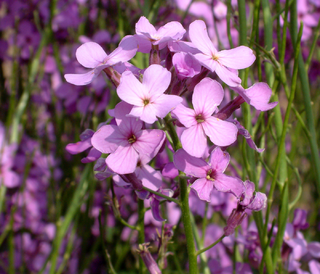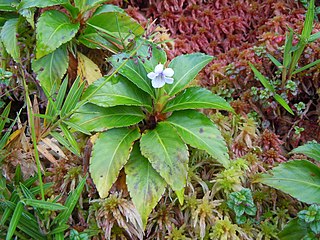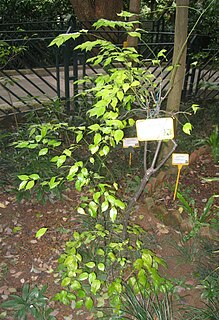
Hesperis matronalis is an herbaceous plant species in the family Brassicaceae. It has numerous common names, including dame's rocket, damask-violet, dame's-violet, dames-wort, dame's gilliflower, night-scented gilliflower, queen's gilliflower, rogue's gilliflower, summer lilac, sweet rocket, mother-of-the-evening, Good & Plenties, and winter gilliflower.

Lobularia maritima is a species of low-growing flowering plant in the family Brassicaceae. Its common name is sweet alyssum or sweet alison, also commonly referred to as just alyssum.

Cardamine hirsuta, commonly called hairy bittercress, is an annual or biennial species of plant in the family Brassicaceae, and is edible as a salad green. It is common in moist areas around the world.

Iberis sempervirens, the evergreen candytuft or perennial candytuft, is a species of flowering plant in the family Brassicaceae, native to southern Europe. The species is often used as an ornamental garden shrub because of its decorative flowers. Iberis is so named because many members of the genus come from the Iberian Peninsula in south west Europe. Sempervirens means "always green", referring to the evergreen foliage.

Iberis gibraltarica, the Gibraltar candytuft, is a flowering plant of the genus Iberis and the family Brassicaceae. It is the symbol of the Upper Rock Nature Reserve in Gibraltar, but is a native of North Africa. Gibraltar is the only place in Europe where it is found growing in the wild. The candytuft grows from crevices in the limestone, and is often seen growing in abundance from the north face of the Rock of Gibraltar. Its flowers range from pale violet to almost white, and can reach up to 8 cm (3.1 in) across.

Iberis umbellata, common name garden candytuft or globe candytuft, is a herbaceous annual flowering plant of the genus Iberis and the family Brassicaceae.
Buddleja candida is a small deciduous shrub widely distributed from north-east India through south east Xizang (Tibet) to the provinces of Sichuan and Yunnan in western China, growing on forest edges, in mountain thickets, and along riverbanks, at altitudes of 1000 – 2500 m. Named and described by Dunn in 1920, the shrub was introduced to cultivation in the west in 1928.
Hypericum acmosepalum is a dwarf shrub in Hypericumsect. Ascyreia that is native to China and known as jian e jin si tao locally.

Viola stipularis, is a species of violet that grows in southern Central America, some Caribbean islands and northern South America; from Costa Rica and Guadeloupe south to Peru.

Ilex asprella, also known as rough-leaved holly and plum-leaved holly, is a deciduous shrub native in South East Asia. Ilex asprella is one of the few deciduous species in the family Aquifoliaceae.

Lepidium heterophyllum,, is a species of flowering plant in the mustard family which is native to parts of western Europe, growing in shingle banks, wasteland or cultivated fields.
Hypericum assamicum is a species of flowering plant in the St. John's wort family, Hypericaceae. It is endemic to India. Hypericum assamicum is one of two species of Hypericum in the section Hypericum sect. Sampsonia.

Passiflora bogotensis is a climbing plant native to Colombia, in the genus Passiflora. It can also be found in Venezuela.

Prunus himalayana, called jyokun shin in Tibetan and 喜马拉雅臭樱 in Chinese, is a species of Prunus native to Nepal, Bhutan, Sikkim and Tibet. It prefers to grow 2,800 to 4,200 m above sea level in the Himalayas. As Maddenia himalaica it was the type species for the now unrecognized genus Maddenia.

Smelowskia americana is a species of Smelowskia known by the common names alpine smelowskia, Siberian smelowskia, and American false candytuft. Native to mountain ranges of western North America including the Olympic Mountains and Cascade Range of Washington and the Rocky Mountains of British Columbia and Alberta south to Colorado, it occurs on rocky outcrops and talus at subalpine and alpine elevations, i.e., from 1,300–4,000 metres (4,300–13,100 ft), and blooms from late May until early September.
Prunus mugus is a species of cherry found in Yunnan province of China and nearby areas of Myanmar and Tibet. A prostrate shrub 1 m tall, it prefers to grow in thickets in the krummholz zone on mountain slopes from 3200 to 3,700 m or even 4,075 m (13,400 ft) above sea level. Heinrich von Handel-Mazzetti, who discovered it, named the species after Pinus mugo, the dwarf mountain pine.
Prunus dictyoneura is a species of bush cherry found in Gansu, Hebei, Henan, Jiangsu, Ningxia, Shaanxi and Shanxi provinces of China. A shrub 0.3 to 1.0 m tall, it prefers to grow in thickets in grasslands on hillsides from 400 to 1600 m above sea level. Chloroplast DNA sequencing has shown that its closest relative is Prunus humilis, at least as far as chloroplasts are concerned.

Castanea seguinii, called Seguin chestnut, Seguin's chestnut, or Chinese chinquapin, and in Chinese: 茅栗, mao li, is a species of chestnut native to south‑central and southeast China.
Hibbertia cistifolia is a species of flowering plant in the family Dilleniaceae and is endemic to northern Australia. It is a prostrate to low-lying sub-shrub with trailing, wiry stems, hairy foliage, oblong to elliptic leaves and yellow flowers arranged in leaf axils, with forty to fifty-eight stamens arranged around the two carpels.
Hedinia is a monotypic genus of flowering plants belonging to the family Brassicaceae. It only contains one known species, Hedinia tibetica.














